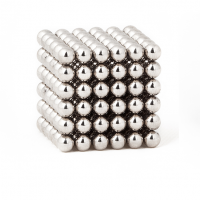Know the Risks of High-Powered Magnets at Home

It started as an ordinary Wednesday, until one of my partners informed me of a patient admitted to our Gastroenterology (GI) service at Children’s Hospital Colorado (Children’s Colorado) who needed our care. The patient was a precocious and otherwise healthy 3-year-old who was admitted overnight after she swallowed a large number of small BB-sized magnets that she had obtained from her father’s desk toy. Her X-rays in the emergency department had shown a ring of 28 magnets in her upper abdomen. Another partner had previously attempted to remove them via an upper endoscopy that same evening. At that time, the magnets had already moved beyond the reach of a conventional endoscope and the patient was admitted for observation to ensure that they would pass.
Unfortunately, her X-rays confirmed our worst fears. The ring of magnets seemed to be stuck in a solitary position, suggesting that they were “pinching” a portion of her bowel and may soon cause a perforation (hole) of her intestine. Though from the outside she looked perfectly well and had no symptoms to speak of, on the inside she literally had a ticking time-bomb that could result in a lifethreatening emergency. Fortunately, using a specialized type of endoscope that can travel like an inchworm through the small intestine, I was able to reach the ring of magnets which were indeed pinching the bowel and remove them before they caused a perforation, avoiding the need for emergent surgery.
I wish I could say the above story was an isolated incident. The truth is, we at Children’s Colorado see patients almost every day with a wide variety of dangerous ingestions, with the list of potential hazards getting longer each year. This story is only one of several alarming ingestion risks facing parents of young children in our society today (including button batteries, fidget spinners, liquid nicotine, laundry products and edible marijuana). By 2010 it was becoming readily apparent in the pediatric GI community that desk toys, containing literally hundreds of high-powered, neodymium BB-sized magnets, were a severe risk for children.
The North American Society of Pediatric Gastroenterology, Hepatology and Nutrition worked with the Consumer Product Safety Commission and safety advocates like Safe Kids to put out a product recall in 2012 and eventually an outright ban on these products in 2014 on the basis of the numerous reports of small children with bowel injury, surgery and even death as a result of these ingestions. After the ban, we saw a dramatic decrease in the frequency of these cases, almost immediately. However, following publication of this blog, a court overturned the CPSC ban on rare earth magnet toys.
Not surprisingly, since that time we once again are seeing the consequences of having innumerable, small, shiny (and sometimes brightly colored) high-powered magnets in the environment of young children. The supporters of these products squarely place the blame of any ingestion injury on the parents of these children, for not providing “appropriate” supervision.
Though this turn of events is disappointing, we must all do what we can as parents to mitigate the risk to our children as much as possible. Below is a list of recommendations to help parents with young children be more aware and cautious of the dangers associated with ingesting these magnets.
Ways to Keep Your Kids Safe Around High-Powered Magnets
- Parental Action, Vigilance: I caution all parents, especially those of young toddlers, against having any of these high-powered magnets in the home. The innate curiosity of a toddler and their natural tendency to explore their environment with their hands and mouths make them too dangerous to have around. There shiny appearance (and sometimes bright colors) carry an attractive force for toddlers beyond their innate magnetism (which is 5x stronger than conventional magnets). Even teens have been known to suffer from dangerous ingestions while using these magnets to simulate nose or cheek piercings.
- Talk to “Play-Date” Families: Communicate with your friends and neighbors to ensure that they too know the dangers of these products and keep them away from where your children or theirs may have access (the same holds true for button batteries, detergent pods and fidget spinners).
- Seek Medical Attention: If you think that a child may have had an ingestion of one or more magnets, seek medical attention IMMEDIATELY so the danger can be assessed and removal, if needed, can be arranged before the magnets pass beyond the reach of conventional endoscopy.
- Get More Information: Review the Consumer Product Safety Commission website for additional resources and information on this topic at https://www.cpsc.gov/Safety-Education/Safety-Education-Centers/Magnets.




